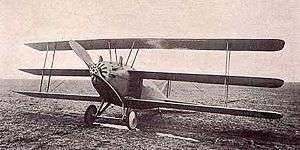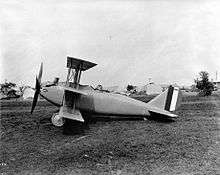Curtiss 18
| Curtiss 18-T Wasp | |
|---|---|
 | |
| Role | twoseat fighter triplane |
| Manufacturer | Curtiss Engineering Corporation |
| Designer | Charles B. Kirkham |
| First flight | 7 May 1918 |
| Introduction | February 1919 |
| Primary user | United States Navy |
| Unit cost |
$55,400[1] |
The Curtiss 18T, unofficially known as the Wasp and by the United States Navy as the Kirkham,[2] was an early American triplane fighter aircraft designed by Curtiss Engineering for the US Navy.
Design and development
The Curtiss 18T was intended to protect bombing squads along the French coast, and a primary requisite for this job was speed. Speed was not the triplane's only salient feature: an 18T-2 set a new altitude record in 1919 of 34,910 ft (10,640 m).[3] The streamlined and very "clean" fuselage contributed to the aircraft's performance. The basic construction was based on cross-laminated strips of wood veneer formed on a mold and attached to the inner structure. The technique was a refinement of that used on the big Curtiss flying boats.[4]
Operational history
Flown by Roland Rholfs, the 18T achieved a world speed record of 163 mph (262 km/h) in August 1918 carrying a full military load of 1,076 lb (488 kg).[5]
The Model 18T-2 was an improved version of its predecessor, boosting 50 additional horsepower. The wings of the new model were swept back. It was also 5 ft (150 cm) longer with a 9 ft (270 cm) longer two-bay wing, though its flight ceiling was 2,000 ft (610 m) lower.
After World War I, it was employed as a racing plane: an 18T-2 nearly won the Curtiss Marine Trophy Race in 1922 (limited to U.S. Navy pilots), but pilot Sandy Sanderson ran out of fuel just before the finish line.[6]
Curtiss Engineering followed the success of the Model 18T with the launch of the Model 18B, unofficially known as the "Hornet", built to otherwise similar specifications.
Variants

- Model 18T or 18T-1
- Two-seat fighter triplane with single-bay wings, powered by a 400-hp (298-kW) Curtiss-Kirkham K-12 piston engine. Referred to by the US Navy as the "Kirkham". Originally designated 18T, the type was redesignated the 18T-1 when the prototype was modified to a new configuration designated 18T-2 (see below).
- Model 18T-2
- 18T with longer-span two-bay wings. Could be fitted with floatplane or landplane landing gear.
- Model 18B
- Biplane fighter version, known unofficially as the "Hornet". Sole flying prototype of Curtiss 18B, USAAS 40058, 'P-86', crashed early in flight trials at McCook Field, Dayton, Ohio, summer 1919. Type not ordered into production. One non-flying prototype also delivered for static testing.[7]
Operators
Specifications (T-1)
Data from Curtiss Aircraft 1907–1947[8]
General characteristics
- Crew: 2
- Length: 23 ft 4 in (7.11 m)
- Wingspan: 32 ft 10 in (9.75 m)
- Height: 10 ft 2 in (3.09 m)
- Wing area: 288 sq ft (26.75 m2)
- Empty weight: 1,980 lb (898 kg)
- Loaded weight: 3,050 lb ()
- Powerplant: 1 × Curtiss K-12 water-cooled 12-cylinder vee engine, 400 hp (298 kW)
Performance
- Maximum speed: 163 mph (142 knots, 262 km/h)
- Endurance: 5.9 hr
- Service ceiling: 23,000 ft (7,010 m)
- Climb to 12,500 ft (3,800 m): 10 min
Armament
- Guns:
- Primary: 2 × forward-firing synchronized .30 in (7.62 mm) Marlin guns
- Secondary: 2 × rear-cockpit .30 in Lewis guns on a Scarff ring, 1 × Lewis gun firing through aperture in aircraft's belly[9]
References
- Notes
- ↑ Angelucci 1987, pp. 114–115.
- ↑ PART 2 Test of Strength 19171919 Archived December 3, 2010, at the Wayback Machine. Retrieved: 13 January 2011.
- ↑ Naval investigation, hearings before the subcommittee of the Committee on Naval Affairs. Washington: United States Senate, 66th Congress, 2d session, 1921. Retrieved: 13 January 2011.
- ↑ "Curtiss # to J." aerofiles.com. Retrieved: 13 January 2011.
- ↑ "Aviation History Facts: August 1." Centennial of Flight, 2003. Retrieved: 13 January 2011.
- ↑ Berliner, Don. "A Concise History of Air Racing." Society of Air Racing Historians, 9 January 2007. Retrieved: 13 January 2011.
- ↑ Green, William, and Swanborough, Gordon, "Fighter A To Z", Air International, Bromley, Kent, UK, February 1976, Volume 10, Number 2, page 98.
- ↑ Bowers 1979, p. 143.
- ↑ Bowers 1979, p. 139.
- Bibliography
- Angelucci, Enzo and Peter Bowers. The American Fighter: The Definitive Guide to American Fighter Aircraft from 1917 to the Present. New York: Orion Books, 1985. ISBN 0-517-56588-9.
- Bowers, Peter M. Curtiss Aircraft 1907–1947. London: Putnam, 1979. ISBN 0-370-10029-8.
- "The Curtiss Model 18-T Triplane." Flight, Volume XI, Issue 22, No. 544, 29 May 1919, pp. 698–700.
- "The Curtiss Model 18-B Biplane." Volume XI, Issue 28, No. 550, 10 July 1919, pp. 902–904.
- Green, William and Gordon Swanborough. The Complete Book of Fighters. New York: Salamander, 1994. ISBN 0-8317-3939-8.
External links
| Wikimedia Commons has media related to Curtiss 18. |